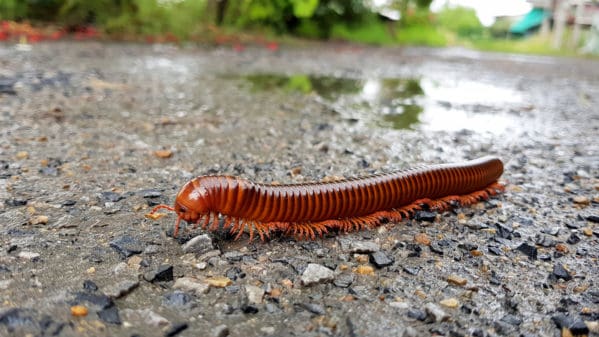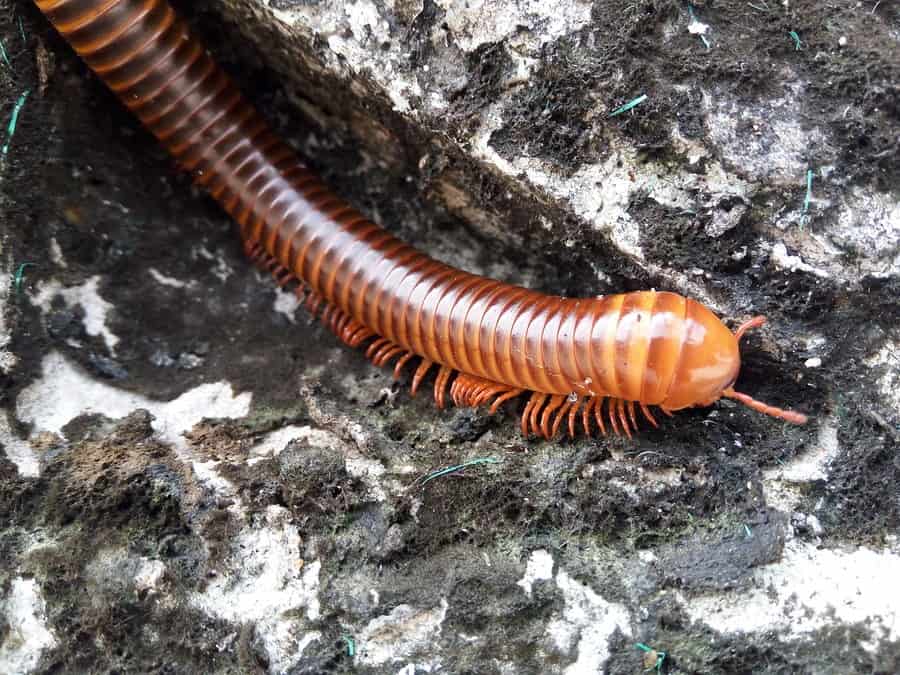READY TO GET STARTED?
REQUEST A FREE ESTIMATE
Fill out the form below or call (888) 466-7849 for a free, no-obligation estimate.

Millipedes are arthropods (not insects) that are commonly found in damp, moist locations. They feed on decaying organic matter. Millipedes will usually hide during the day and come out at night when the humidity is higher and dew is present on the ground. Millipedes are often mistaken for centipedes – they have elongated, worm-like bodies with 2 pairs of legs on each segment of their bodies. They are usually about 1 inch long with a hard, round, cylindrical body that is brown to black in color. When they are disturbed or dead they will curl into a spiral.
Finding a millipede in the house is not common. They cannot reproduce indoors and usually only come inside when there is a period of extreme wetness (during the rainy season) or in search of somewhere to overwinter (usually in late Fall). Millipedes are most commonly found in gardens but when they do come indoors they are usually found in the garage, basement, or the lowest level of the home. Millipedes that wander indoors typically die in a short amount of time because of the dryness.
If a millipede does get into your home, are they helpful or harmful? Should you be concerned? Millipedes are NOT harmful to humans. They do not feed on buildings, structures, or furnishings. They also cannot bite or sting. In fact, they can be beneficial in your compost pile as they help to break down the contents. They can cause damage to your garden by destroying seedlings or feeding on vegetables; however, there is no need to eliminate them unless they are causing damage to your plants.
While a millipede infestation is rare, there are things you can do to help prevent these pests from getting into your garden or home. Here are some tips on how to get rid of millipedes:
Take the Homework, Leave the Lice

Millipedes, also known as “thousand leggers,” are arthropods that often make their way into our homes. Millipedes range from 2.5 to 4 cm long, are brownish in color, are long and slender, and look a lot like worms with legs. They are segmented with 2 pairs of legs per segment. Millipedes are nocturnal and tend to move in large numbers. They are also scavengers, feeding on decaying plant material in and around your home. While they are definitely creepy looking, they don’t bite or cause any damage to your home or food supplies.
Millipedes are often found outdoors in damp places such as mulch, flowerbeds, under leaves, compost, rotting wood, and under stones in your yard. They are also commonly found around foundations. Excess rain, drought, and cooler temperatures can make their outdoor habitats less favorable for them and you will often see millipedes in the house during these conditions. Excess rain will drive them indoors in search of shelter and drought will drive them indoors in search of water. Once in your home, they tend to gravitate toward damp areas such as laundry rooms, basements, and crawlspaces. Millipedes will usually die fairly quickly once they get inside due to the lack of moisture. If you’re wondering how to get rid of millipedes indoors, you can simply remove them with a vacuum cleaner or shop-vac.
How can you prevent a millipede infestation from taking over your home? Here are a few tips to prevent millipedes in the house.
What to Expect When Signing Up for Termite Protection
Lawn Care: What’s Causing Yellow Spots on Your Lawn & How to Fix It